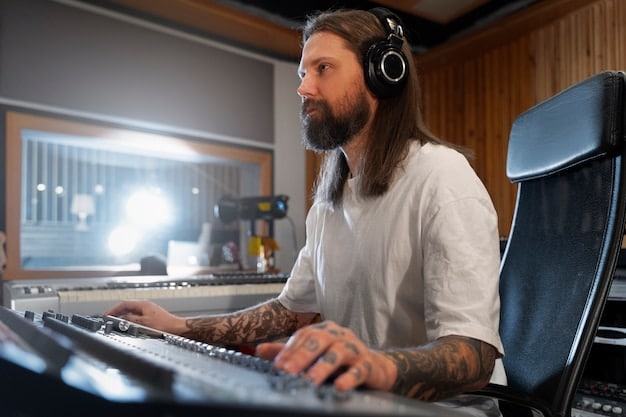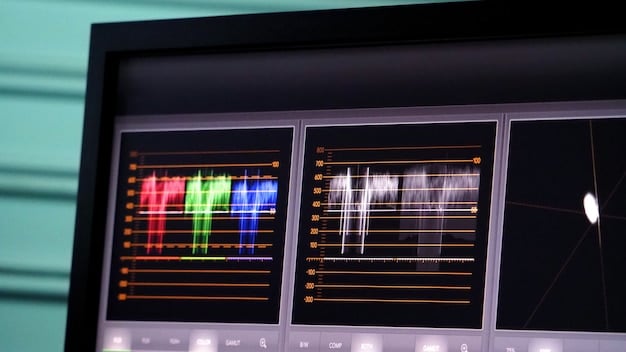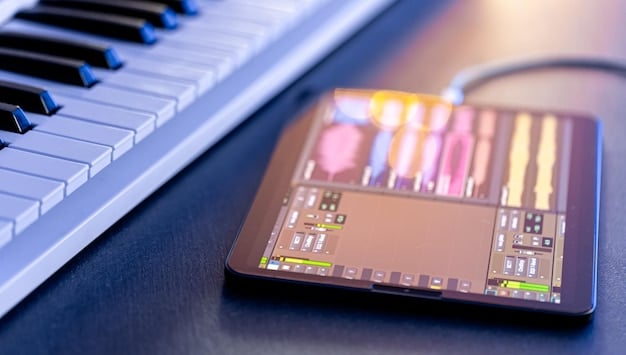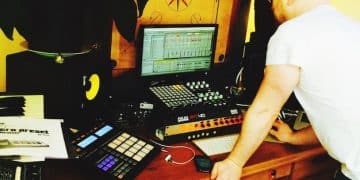Optimize Your Beatmaking: Streamlining Workflow for Music Production

Streamlining your beatmaking workflow involves organizing your tools, creating templates, and mastering shortcuts to boost creativity and efficiency in music production.
Are you ready to take your beatmaking to the next level? A streamlined beatmaking workflow isn’t just about speed; it’s about unlocking your creative potential and making music production a more enjoyable process. Let’s dive into how you can optimize your workflow and create more music in less time.
Understanding the Importance of a Beatmaking Workflow
A structured beatmaking workflow can be a game-changer for music producers. It not only saves time but also reduces mental clutter, allowing you to focus on the creative aspects of music production. Without a defined process, you might find yourself wasting valuable time on repetitive tasks or struggling to find inspiration.
A well-designed workflow ensures that you can quickly transition from concept to completion, turning your musical ideas into fully realized tracks.
Why Workflow Matters
A solid beatmaking workflow provides several benefits:
- Efficiency: Reduces the time spent on each beat.
- Consistency: Helps maintain a consistent quality and style.
- Creativity: Frees up mental space for creative exploration.
- Organization: Keeps your projects and files organized.
By understanding these benefits, you can better structure your approach to music production and optimize your creative output.

Setting Up Your Beatmaking Environment
The first step in streamlining your beatmaking workflow is to organize your production environment. This includes both your physical studio space and your digital resources.
A well-organized environment minimizes distractions and allows you to quickly access the tools and sounds you need.
Physical Studio Setup
Creating an efficient physical setup involves:
- Ergonomics: Ensure your workstation is comfortable and ergonomic to prevent fatigue.
- Accessibility: Keep essential tools like MIDI controllers, audio interfaces, and headphones within easy reach.
- Acoustics: Optimize your room’s acoustics for accurate monitoring.
Digital Studio Setup
Your digital setup should be equally organized:
- DAW Organization: Create templates and presets for your preferred instruments and effects.
- Sample Management: Organize your samples into clear, searchable folders.
- Plugin Selection: Curate a collection of essential plugins to avoid analysis paralysis.
By structuring both your physical and digital environments, you create a conducive space for creativity and productivity.
Creating Beatmaking Templates
Using templates can significantly speed up your workflow by providing a pre-configured starting point for each project. Templates save you from having to set up basic elements every time you start a new beat.
A good template includes your preferred instruments, effects, and routing configurations, allowing you to jump straight into the creative process.
Essential Template Components
Your beatmaking template should include:
- Drum Rack: A pre-loaded drum rack with your go-to sounds.
- Instrument Tracks: Several MIDI tracks loaded with your favorite virtual instruments.
- Effect Chains: Pre-configured EQ, compression, and reverb settings.
- Routing: Established routing for sends and returns, such as reverb and delay buses.
Customizing your template to match your personal preferences and style ensures that you are always starting from a place of familiarity and comfort.

Mastering Beatmaking Shortcuts and Techniques
Efficiency in beatmaking also comes from knowing and using shortcuts and techniques that streamline your process. These shortcuts can range from DAW-specific commands to creative sampling techniques.
Mastering these methods allows you to work faster and more intuitively, turning your ideas into reality with greater ease.
DAW Shortcuts
Learn and use essential DAW shortcuts:
- Copy/Paste: Quickly duplicate elements.
- Quantize: Correct timing issues.
- Automation: Create dynamic changes.
Creative Techniques
Explore techniques like:
- Sampling: Chop and manipulate samples creatively.
- Sound Design: Create unique sounds using synthesis and effects.
- Arrangement: Quickly structure your beats using arrangement techniques.
Combining technical shortcuts with creative techniques accelerates your workflow and enhances the quality of your music.
Streamlining Your Mixing and Mastering Process
Mixing and mastering are crucial stages in beatmaking, and optimizing these processes can save significant time. Developing a consistent approach to mixing and using mastering presets can ensure your tracks sound polished and professional.
By establishing a clear mixing and mastering workflow, you can achieve a consistent sound and avoid getting bogged down in endless tweaking.
Mixing Tips
Consider these mixing strategies:
- EQ and Compression: Use these tools to shape and balance your sounds.
- Gain Staging: Set levels properly to avoid clipping.
- Panning: Create stereo width and separation.
Mastering Strategies
For mastering:
- Limiters: Use limiters to maximize loudness.
- EQ: Apply subtle EQ adjustments to enhance clarity.
- Stereo Imaging: Widen or narrow the stereo image for effect.
Using these guidelines, you can improve the quality of your beats and create a professional sound without spending excessive time on mixing and mastering.
Staying Organized and Focused
Maintaining organization and focus is vital for a productive beatmaking workflow. This involves managing your files effectively, setting goals, and avoiding distractions.
A clear and focused approach ensures that you make the most of your studio time and achieve consistent results.
File Management
Effective file management includes:
- Naming Conventions: Use consistent naming conventions for your projects and files.
- Backup: Regularly back up your work to prevent data loss.
- Version Control: Use version control to track changes and avoid confusion.
Focus and Productivity
To stay focused:
- Set Goals: Define clear goals for each session.
- Minimize Distractions: Turn off notifications and avoid social media.
- Take Breaks: Take regular breaks to refresh your mind.
By implementing these organizational and focus strategies, you can maintain a high level of productivity and create high-quality beats consistently.
Conclusion
In conclusion, a streamlined beatmaking workflow is essential for any music producer looking to maximize their creative output and efficiency. By organizing your environment, creating templates, mastering shortcuts, and staying focused, you can significantly enhance your music production process and create more music in less time.
| Key Point | Brief Description |
|---|---|
| 🛠️ Environment Setup | Organize your physical and digital studio for quick access to tools. |
| 🎼 Template Creation | Use pre-configured templates to start projects faster. |
| 🎹 Shortcuts & Techniques | Master DAW shortcuts and creative techniques for efficiency. |
| 🎧 Mixing & Mastering | Streamline mixing and mastering with presets and consistent approaches. |
FAQ
▼
A beatmaking workflow is a structured approach to creating music, including steps like environment setup, template creation, mastering shortcuts, and efficient mixing and mastering. It optimizes the production process for creativity and productivity.
▼
A good workflow saves time, reduces mental clutter, and allows you to focus on creative aspects of music production. It ensures consistency, improves efficiency, and helps you translate ideas into completed tracks faster.
▼
Templates provide a pre-configured starting point with instruments, effects, and routing already set up. This reduces setup time, allowing you to jump directly into the creative process and maintain a consistent sound.
▼
Essential DAW shortcuts include copy/paste, quantize, and automation. These help in quickly duplicating elements, correcting timing issues, and creating dynamic changes, significantly speeding up the production process.
▼
Stay organized by using consistent file naming conventions, backing up your work regularly, and using version control. Stay focused by setting clear goals, minimizing distractions, and taking regular breaks to refresh your mind.
Conclusion
By implementing these strategies, you can create a beatmaking workflow that enhances your productivity, creativity, and the overall quality of your music. Taking the time to optimize your process is an investment that will pay off in every track you create.





